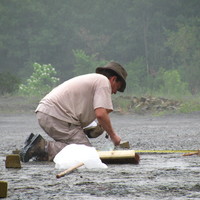Papers by Paul O'Donoghue

Wader Study, 2016
Intertidal oyster cultivation is a widespread activity and has the potential to cause negative im... more Intertidal oyster cultivation is a widespread activity and has the potential to cause negative impacts to waterbirds. The aim of this study was to determine whether waterbird species show positive, neutral, or negative patterns of associ- ation with the presence of oyster trestles. We carried out an extensive study across six sites, and an intensive study at one site, in southern Ireland, to examine waterbird distribution patterns in relation to the presence of intertidal oyster cultivation. Grey Plover Pluvialis squatarola, Red Knot Calidris canutus, Dunlin C. alpina and Bar-tailed Godwit Limosa lapponica, and a further six species with more limited data, showed strong negative patterns of association with oyster trestles. Eurasian Oystercatcher Haematopus ostralegus, Redshank Tringa totanus, Ruddy Turnstone Arenaria interpres and European Herring Gull Larus argentatus showed neutral/positive patterns of association. Five other species showed neg- ative patterns of association at some sites, and neutral/positive patterns at other sites. A few waterbird species may benefit from the presence of oyster trestles, but many intertidal waterbird species in typical north-western European coastal sites show a negative association with the presence of oyster trestles, at least at some sites, highlighting the importance of carrying out site-specific assessments of the impact of intertidal oyster culture on waterbird populations.

Contents: The Economic Value of Natural Capital and Ecosystem Services / John Box -- Building urb... more Contents: The Economic Value of Natural Capital and Ecosystem Services / John Box -- Building urban biodiversity through financial incentives, regulation, and targets / John Box -- Delivering urban greenspace for people and wildlife / John Box -- Briefing: Keeping up with the Suds revolution and legislative evolution / Joanne Goodson -- Assessing the Environmental Impact: Are Stormwater Ponds More Effective Than Presumed? / David A Tomasko, Emily H Keenan, Shayne Paynter and Megan Arasteh -- Experimental studies on the effects of nutrient loading and sediment removal on water quality in Lake Hancock / David A Tomasko, Emily C Hyfield Keenan, Loreto C DeBrabandere, Joseph P Montoya and Thomas K Frazer -- Managing Water Quality in Huntsman Lake (Virginia, USA)—Development and Implementation of Restoration Strategies / David Tomasko, Emily Keenan and Shannon Curtis -- Sustaining high nature value farming systems: lessons from the west of Ireland / George F Smith, Paul O’Donoghue and Cl...
Ringing & Migration, 1998

Mute Swan population genetics were investigated from four localities throughout Ireland using pro... more Mute Swan population genetics were investigated from four localities throughout Ireland using protein electrophoresis. The products of ten presumptive loci were assayed in red blood cells and one in blood plasma. All but the latter (plasma esterase) were monomorphic. Allele frequencies at the EST locus did not differ significantly from previously published values from England and Scotland nor was there a significant spatial or temporal heterogeneity apparent within Ireland. These results do not support the hypothesis of reproductive isolation of Irish swan populations from England and Scotland or within Ireland. The previously recorded presence of limited variability in the English and Scottish Mute Swan populations at one locus (Lactate dehydrogenase) compared to those assayed in Ireland (where it was monomorphic) may mean that introduction(s) involved a limited number of individuals.

Intertidal oyster cultivation is a widespread activity and has the potential to cause negative im... more Intertidal oyster cultivation is a widespread activity and has the potential to cause negative impacts to waterbirds. The aim of this study was to determine whether waterbird species show positive, neutral, or negative patterns of associ- ation with the presence of oyster trestles. We carried out an extensive study across six sites, and an intensive study at one site, in southern Ireland, to examine waterbird distribution patterns in relation to the presence of intertidal oyster cultivation. Grey Plover Pluvialis squatarola, Red Knot Calidris canutus, Dunlin C. alpina and Bar-tailed Godwit Limosa lapponica, and a further six species with more limited data, showed strong negative patterns of association with oyster trestles. Eurasian Oystercatcher Haematopus ostralegus, Redshank Tringa totanus, Ruddy Turnstone Arenaria interpres and European Herring Gull Larus argentatus showed neutral/positive patterns of association. Five other species showed neg- ative patterns of association at some sites, and neutral/positive patterns at other sites. A few waterbird species may benefit from the presence of oyster trestles, but many intertidal waterbird species in typical north-western European coastal sites show a negative association with the presence of oyster trestles, at least at some sites, highlighting the importance of carrying out site-specific assessments of the impact of intertidal oyster culture on waterbird populations.











Uploads
Papers by Paul O'Donoghue